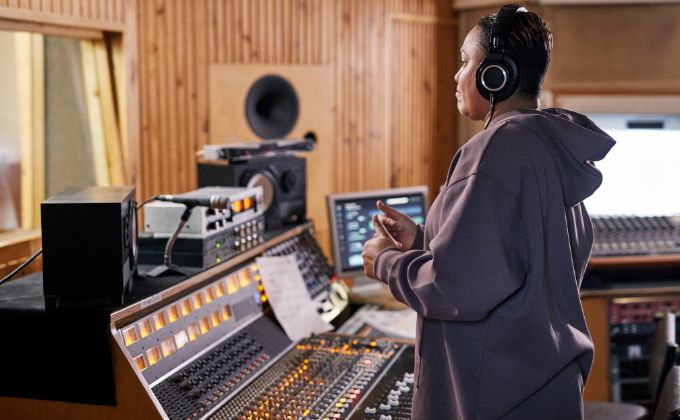Backing tracks have become an integral part of modern music performance, supporting live shows, studio recordings, and even amateur musicians looking for professional sound. Their evolution is a fascinating journey, shaped by technological advancements, changing musical needs, and the quest for a more polished live performance. This article will explore the development of backing track producer, tracing their transformation from simple studio tools to vital assets on today’s global stages.
The Origins: Backing Tracks in the Studio
Backing tracks originated in the studio environment, where they were primarily used to enhance recordings. In the early days of multitrack recording during the 1950s and 60s, musicians and producers would layer instruments and vocal parts onto tape, one at a time. This allowed them to create complex, polished songs that were impossible to perform live with just the standard band setup. These recordings, or “playbacks,” served as a foundation on which artists could build their final tracks.
In this era, the primary goal of using backing tracks in the studio was to provide a cleaner, more organized sound without the limitations of live performance. Musicians could perform each part perfectly, then assemble the best takes into a flawless production. Over time, the advantages of multitrack recording became widely recognized, and more artists and bands embraced backing tracks as part of the recording process.
The Introduction to Live Performances
It wasn’t long before musicians saw the potential of bringing the refined sound of studio recordings into their live performances. Initially, using backing tracks in concerts was rare, as live music had a rawer, more organic feel. But as audiences grew to expect the same polished sound they heard on albums, musicians began experimenting with ways to incorporate backing tracks on stage.
In the 1970s and 80s, technological innovations made it easier for artists to use pre-recorded tracks in live settings. The rise of synthesizers and drum machines allowed musicians to simulate instruments and sounds they couldn’t easily reproduce live. Bands like Queen, Depeche Mode, and Pink Floyd began incorporating backing tracks into their shows, adding layers of sound that would otherwise require extra musicians. With the advancement of portable tape machines and later digital playback devices, this became more accessible to artists across genres.
Digital Revolution: The 1990s and Early 2000s
The 1990s marked a major turning point in the use of backing tracks, thanks to digital technology. As computers and software became more sophisticated, musicians could create and control intricate backing tracks with ease. Portable samplers, sequencers, and digital audio workstations (DAWs) like Pro Tools and Logic Pro enabled artists to design backing tracks with precision and flexibility.
This was also the era when artists began blending live musicianship with pre-recorded elements seamlessly. Backing tracks were no longer viewed as mere add-ons; they became essential components of the performance. Some artists began relying heavily on them to recreate the intricate layers and textures found in their albums. Pop, hip-hop, and electronic acts, in particular, embraced this approach, allowing for more complex shows that involved choreography, lighting effects, and visual elements synchronized with the backing tracks.
Backing Tracks in the Modern Live Performance
By the 2010s, backing tracks had become commonplace in almost every genre of live music. Advanced playback technology allowed for even more precise control over live performances. Digital platforms like Ableton Live gave musicians the power to manipulate their backing tracks in real-time, introducing flexibility into their shows. Artists could now loop sections, change song arrangements on the fly, and create custom effects during their performances.
Backing tracks also became a valuable tool for solo performers and smaller bands. With the help of pre-recorded tracks, even a single musician could simulate the sound of a full band, opening up new possibilities for live gigs. From indie acts to arena-filling stars, performers across the spectrum began relying on backing tracks to add richness and depth to their shows.
Backing Tracks in the Age of Virtual Concerts
The global pandemic in 2020 marked yet another significant moment in the evolution of backing tracks. As live venues closed, many artists turned to online performances to connect with their fans. Backing tracks played a crucial role in these virtual concerts, often standing in for missing band members or adding a professional sheen to home-recorded performances.
The increasing quality of digital music production meant that artists could replicate the experience of a live concert from their own homes. Advanced DAWs, paired with video production tools, enabled musicians to deliver high-quality performances without needing full band setups. In some cases, backing tracks allowed artists to collaborate remotely, with each musician recording their parts separately and combining them into one cohesive performance.
The Future of Backing Tracks: Creative and Immersive Performances
As technology continues to evolve, so will the role of backing tracks in live performances. Immersive sound experiences, such as 3D audio and surround sound, are opening up new ways to integrate pre-recorded elements into live shows. Additionally, the growing trend of using virtual reality (VR) and augmented reality (AR) in concerts will likely see further innovations in how backing tracks are used, creating fully immersive and interactive performance experiences.
For both established stars and emerging artists, backing tracks are more than just a convenience—they’re a powerful creative tool. Whether enhancing the sonic landscape of a live show or enabling solo performers to deliver dynamic performances, backing tracks have become an essential part of the modern musician’s toolkit. From humble beginnings in the recording studio to their prominent role in today’s live performances, backing tracks have truly come of age.
Conclusion
The evolution of backing tracks reflects broader changes in the music industry, where technology and creativity intersect. What started as a studio tool has become an indispensable element of live performance, allowing musicians to push the boundaries of what is possible on stage. As technology continues to advance, the future of backing tracks promises to offer even more innovative and exciting possibilities for artists and audiences alike.



